-

人教版高中英语必修2Cultural Relics说课稿2篇
Ⅲ. Analysis of the teaching material:The topic of this unit is cultural relics. Students are quite interested in topics about different cultures around the world. This is the second period of the whole unit. As a reading class, the passage mainly talks about the history of the amber room (how it was made, sent as a gift, lost and rebuilt).According to the new national curriculum, when teaching reading, much emphasis should be put on training the students’ reading skills.Ⅳ. Teaching objectives1. Language objectives:1) Students are required to master the key words and phrases occurred in the passage (e.g. amazing, decorate, belong, in return, less than etc.)2) Students are required to learn the attributive clause and acquire the sentence pattern.2. 1) Students are required to describe a certain thing by using the new sentence patterns.2) Students are required to master two kinds of reading skills—skimming and scanning, and learn to use them in their daily reading.3. 1) Students are required to know the history of the amber room.2) Students are required to appreciate cultural relics and understand the importance of protecting them.Ⅴ. Teaching important and difficult points1) the new words, phrases, and sentence pattern in the course of reading.2) Teaching difficult point: Help the students master two kinds of reading skills—skimmingand scanning and learn to apply them in daily use.Ⅵ. Teaching methods:Task-based method & Top-down model Ⅶ. Teaching aids: PPT, pictures, blackboard Ⅷ. Teaching procedure:

人教版高中英语必修3Astronomy the science of the stars说课稿3篇
Step 2 Pre-listeningAfter students finish their discussion, I will show a picture of Newton and ask them: Who is him? What is he famous for? Could you find out some words to describe him? Maybe students will answer that he is genius for his finding of theGravitation, making a great contribution to the progress of human being. At that time I will show another two pictures of Einstein and Hawking, letting students guess who they are and write down their idea about the Gravitation. For I have arranged them to search more information about the gravity before this class, Students have beenfamiliar with the topic and will not be afraid about this abstract conception, which is helpful for their listening.Step 3 While-listeningIn this step, students will be required to listen the material for three times. The first and listening is extensive listening and the second and third listening is intensive listening. In the first time, They are required to listen a material including Part 1 and Part 2 and choose the best summary of the listening text. After they choose the right answer, They also need work in group to explain what is wrong with the others. Then I will make a conclusion that we should pay attention to the first paragraph and last paragraph and some keys to get the main idea. By doing this, their capacity of generalization will have a great improvement.Before the second listening, I will ask students to scan the blank on the power point quickly and ask them to note down some key words .Then ask them to listen to the Part 1again and fill the first column of the chart. Maybe some students just show the ideas of these three scientists an still can’t catch their development of gravity. Therefore, I will ask them to listen to Part 2 again and fill in the rest. After finish the listening, I will give them ten minutes to discuss with their partner. I will also guidethem to improve their answers when they discuss with others.

人教版高中英语必修4A taste of English Humor说课稿3篇
Then I would ask them to think of a funny English or Chinese and tell it to partners. While telling stories, they can use expressions and some acting to help make the story funny. 5 minutes would be given to do this.Those stories they told there will be the material for their writing. Soletting them tell it at first is helpful. And they can make a difference between telling a funny story and writing it down. Generally speaking, it is difficult forstudents to write well because they don’t know what to write and how to write. Asking them to tell their own stories at first can help them come up with what to write.After their telling, I would invite someone to share his/her story with all of us and I would write it down on the blackboard.This example story would be used as a sample to illustrate the format of funny story. Different from a story from teacher or textbook, a story from students can obviously become a interesting material to draw students’ attention.Then I would ask the whole class to put this story into several parts. It might be a little bit difficult for them. So I would ask them to find out whether all the sentences are necessary. After delete some sentences, there are 6 sentences left behind. Then they can easily put them into three parts. After interaction with students, I would teach them the right terms for each part and conclude the format of funny story.This step is the key and difficult point in my lesson. So I mainly usetask-based teaching method in this part and the task for students was divided into several stages. With the separated difficult level, students can find there are usually three parts in writing. They can also learn to write without the unnecessary parts in the process of analyzing. And then I wouldn’t rush to tell them the right terms to them directly. Instead, I would ask them to name them by their own. A confused mind is better for acquiring knowledge.While-writing:Then I would give students 7 minutes to write down this story, without other requirements.With all the preparations in pre-writing, students’ difficulties were cleared. So it would be much easier for them to write down the story within 7 minutes. There are no other requirements because students’ first writing is actually a drafting. It would be revise and edit several times later. Writing, as a skill

人教版高中英语必修4Women of achievement说课稿4篇
Good morning, distinguished judges:It’s my honor to talk about my teaching ideas with you. Today my topic is Women of Achievement. My presentation consists of six parts: the analysis of teaching material and student, teaching aims, key and difficult points, teaching and studying method, teaching procedures and blackboard design.First, let’s focus on the analysis of teaching material. This lesson is from New Senior English for China Student’s Book 4 Unit 1, the reading part. The main topic of the passage is the introduction of a student of Africanwildlife. After this lesson, the students will learn more information about her studying chimps in Africa, and their reading and speaking abilities can be developed as well.The next part is the analysis of students. My students are in senior high students. They have learnt English for many years, they’ve known many words and sentences, but their speaking and reading abilities are still not very good. So I will practice their speaking and reading abilities through different exercises.According to the New Standard Curriculum and the present situation, I set the teaching aims as follows: firstly, knowledge aims. Students can grasp some new words, such as worthwhile, move off. Moreover, students can understand the content of the passage and get familiar with the topic of studying chimps in wildlife. Secondly, ability aims. Students can use reading strategies such as skimming and scanning in reading process. Thirdly, emotional aims. Students can have the awareness of protecting animals and care about animals.Based on the above analysis, the key point of this lesson is to get the main idea and the detailed information from the passage; the difficult point is to talk about the wildlife protection and use reading strategies.

人教版高中英语必修4Theme parks说课稿3篇
The oldest and the most popular park in the worldenjoy the exciting activities thereget close to the life-size cartoon characters like Mickey Mouse and Donald Duck Step 3 Pre-reading1.What do you suppose a theme park is ?2.What do you think you can see in a theme park?(1.It is a kind of amusement park which has a certain theme – that the whole park is based on. 2.buildings, castles, statues, rare animals and birds, and so on.) Step 4 Reading ----- Theme Parks –---- Fun and More Than Fun1.Predict : Read the title and the pictures on P. 34 and PredictWhat is the meaning of the title “Theme Park – Fun and more than fun”?(The title means that theme parks are fun to visit, but that they can also be educational and can offer useful information.)2.Skimming Fast read and answer:What activities can we take in a theme park?Amusement park: Bumper car Merry-go-round slide bungee jumping Free-fall rides Horror films Pirate ship Ferris wheel roller coaster3.Scanning Read again and you will find various theme parks are mentioned in the passage . Then what are they ?Theme parks: Sports theme park History theme park Culture theme park Marine or Ocean theme Park Future park Science theme park Disneyland4.Careful reading and find the main idea of each paragraph:THEME PARKS---- entertaining/ educationalPara.1 Traditional parks are places to go for relaxation and to have time away from our busy lives.Para.2 Theme parks are different They’re large and full of things to do, see and buy.Para.3 Theme parks are built around a single idea or theme. One example is a sports park.Para.4 Another kind of theme park is historical more and cultural and can be educational.Para.5 Disneylandwas the first theme park. It is based on the fantasy life and characters of Disney’s films.Para.6 Some examples of educational theme parks include sea world parks and science parks.

人教版高中英语必修4Working The Land说课稿3篇
Knowledge objectives:(1) to make Ss grasp the usage of words, expressions and sentence structures: statistics, struggle, thanks to, rid of, some patterns for persuasion, the “ing” form as subject and object;(2)to use learnt knowledge to persuade sb.Ability objectives:(1) to develop Ss’ reading skills(skimming, scanning, word guessing);(2) to improve Ss’ speaking, communicating and cooperating skills.Emotional objectives:to make Ss know the contribution of Yuan,and learn his spirit and his simple life time.Teaching important and difficult points:(1) some words, expressions and sentence structures mentioned above;(2)the content of the text;(3)training their reading and speaking skills.Teaching methods: CLT, TBLT,QT.Learning strategies: CLS, QLS, TBLS.Teaching procedures:Step 1 lead-in: (1) teacher plays a piece of recent news from CCTV about the harvest of the super hybrid rice, and ask students whether they know Yuan or not, and talk about him and his contribution.(2)Brain storm: let Ss describe Yuan in their minds including his appearance, his living condition and so on.Step 2 fast reading tasks:(1)teacher introduces Yuan and super hybrid rice(2)make Ss read the text as fast as possible with questions. Such as: what’s the general ideaof this passage? What’s Yuan’ dream? (skimming and scanning skill)Step 3 intensive reading tasks(1)let Ss read the text silently, find topic sentence of each paragraph and draw the difficult sentences and the knowledge what they don’t understand.(words guessing)(2)teacher and Ss talk about the important words, expressions and sentences together, and ask Ss to retell the content of the text.(summarizing and paraphrasing)(3)teacher summarize this part.(4) read again following the courseware.

人教版高中英语必修5First aid说课稿6篇
In this class, I have 3 teaching aims, that is, knowledge aims, ability aims and emotion aims.1) Knowledge-Teach students new words and expressions, such as temporary, bleed,sprain choke, first aid, fall ill and so on.-Enable students to have a better understanding for some basic knowledge of first aid.2) Ability-Train students’ speaking, reading and writing abilities by different teaching activities, such as skimming, comprehending, team work, role play, retelling and writing.-Develop students’ reading strategy on how to move general idea to specific information.3) Emotion-Promote students’ awareness of giving first aid.- Cultivate students’ creativities.Then let’s come to my teaching methods and activities.III. Teaching methods and activities:To achieve different teaching aims, various kinds of teaching methods and activities will be adopted throughout this period, such as TBL (task-based learning), skimming, team work, brainstorm and others, which can offer students opportunities to fulfill tasks in which they can use language to achieve a specific outcome.IV. Teaching aids:Computer and blackboardV. Teaching important points:1) Make students have a clear mind for the structure of the text.2) Help students understand the theme of the text.VI. Teaching difficulties:1) So many new words may affect students’ understanding.2) How to get students to know about the functions of the skin and thecauses, characteristics and treatments for different degree burns,and the knowledge about giving first aid. VII. Blackboard design:

人教版高中英语必修5Life in the Future说课稿5篇
Good afternoon, everyone. It’s my great pleasure to be here sharing my lesson with you. The content of my lesson is Senior English for China Book5 Unit 3 Life in the Future. I’ll be ready to begin this lesson from six parts: Analysis of the teaching material, Analysis of the students, Teaching aims and important and difficult points, Teaching methods and aids, Teaching procedures, and Blackboard design. First, let me talk about the teaching material.Part 1 Analysis of the Teaching Material:This unit is about what human beings’ life will be like in about one thousand years. By studying of this unit, we’ll Enable the students to know the changes in humans’ life and some new inventions bringing about the change and develop the interest in science. This lesson plays an important part in the English teaching in this unit. This is an important lesson in Book Five. From this lesson, it starts asking the Ss to grasp contents of each passage. Therefore, this lesson is in the important position of the teaching material. If the Ss can learn it well, it will be helpful to make the Ss learn the rest of this unit.Part 2 Analysis of the SsAs Senior2 Ss, they are at different levels of English fluency, some of them have lost interest in English. So during the lesson, I arrange a variety of activities to let all of them join in to attract their interest and let them be confident and taste the joy of success.

人教版高中英语必修5The United Kingdom说课稿4篇
Teaching Aims:Knowledge 1. Get the students to learn the useful new words and expressions in this section. Aims:2. Let the students learn about how the UK was formed and the four groups of invaders.1. Develop students’ reading ability and let them learn different Ability reading skills. Aims:2. Enable students to learn to talk about the United Kingdom and the Union Jack Emotional 1. Let students know more about the UK2. Develop students’ sense of cooperative learning Aims:Teaching Important Points:1. Let the students learn about the countries of the United Kingdom and the Union Jack2. Get the students to read the passage and know about how the UK was formed and the four groups of invaders.3. Have the students learn different reading skills.Teaching Difficult Ponts:1. Develop students’ reading ability.2. Enable students to talk about the United Kingdom and the Union Jack.3. Let students learn how the UK was formed geographically and historically.Teaching Methods:Showing pictures, asking, exercising, listening, reading etc.Teaching Aids:A computer,a projector and a blackboard.Teaching Procedures: 1) Show a map of the world, ask students the following questions:Where is the UK?What’s the full name of the UK?2) Ask the students work in pairs to do the quiz on Page 9.Do you want to test how many things you know about the United Kingdom? Let’s have a small test.Using the map on P9, students answer the following questions:?How many countries does the UK consist of? What are they??England is divided into three main areas. Do you know what they are? 1) Scanning (10Minutes )Let the students hold the questions asked in pre-reading and read the passagequickly and then let them do the following exercise.Join lines to the right answer.
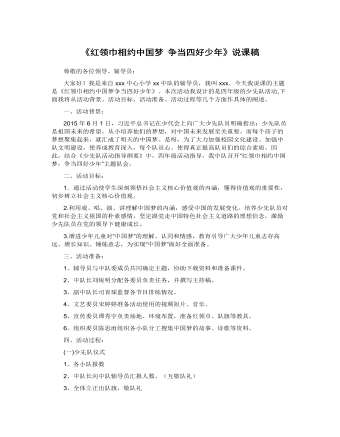
《红领巾相约中国梦 争当四好少年》说课稿
3、展梦想。第三小队通过演讲的形式,展示了自己的中国梦。队员分组通过朗诵诗歌、讲故事和演讲展示自己的中国梦,充分发表自己对社会主义核心价值观的理解,坚定争做四好少年的信心。〖设计意图:社会主义核心价值观比较抽象化,四年级的学生理解起来比较困难,让学生通过表演的形式,在某种程度上视觉感官接受要比抽象图更容易〗第三版块:深入研讨——领悟价值观看各小队表演之后,中队长启发队员们结合自身情况交流学习体会,讨论以下四个问题:(1)观看了视频和同学的表演后,你有什么感想?(2)如何学习树立自己的中国梦?(3)如何用实际行动践行社会主义核心价值观,实现自己的中国梦?让学生结合自身的特点,为自己设定合适的价值观。在此基础上让队员们齐声唱《红领巾心中飘》,道出自己心中的梦想。
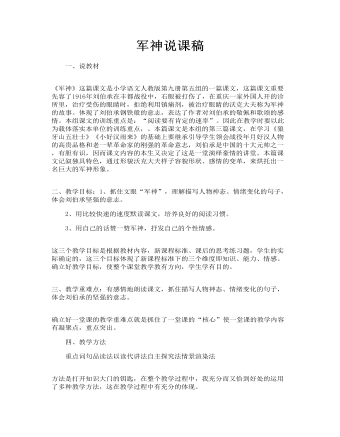
军神说课稿
二、教学目标:1、抓住文眼“军神”,理解描写人物神态、情绪变化的句子,体会刘伯承坚强的意志。 2、用比较快速的速度默读课文,培养良好的阅读习惯。 3、用自己的话赞一赞军神,抒发自己的个性情感。 这三个教学目标是根据教材内容,新课程标准、课后的思考练习题,学生的实际确定的,这三个目标体现了新课程标准下的三个维度即知识、能力、情感。确立好教学目标,使整个课堂教学教有方向,学生学有目的。 三、教学重难点:有感情地朗读课文,抓住描写人物神态、情绪变化的句子,体会刘伯承的坚强的意志。 确立好一堂课的教学重难点就是抓住了一堂课的“核心”使一堂课的教学内容有凝聚点,重点突出。 四、教学方法 重点词句品读法以读代讲法自主探究法情景渲染法 方法是打开知识大门的钥匙,在整个教学过程中,我充分而又恰到好处的运用了多种教学方法,这在教学过程中有充分的体现。
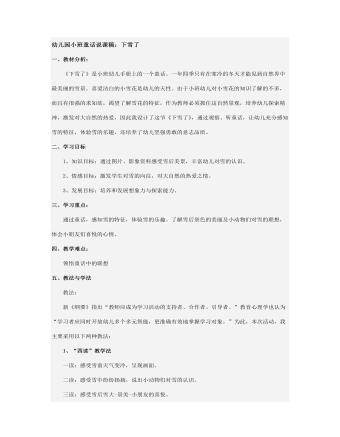
幼儿园小班童话说课稿:下雪了
1、创设情境,激趣导入 先谈话导入“小朋友们现在是什么季节,天气冷吗?”。 事先准备好“雪花”(泡沫削)放在有缝隙的篮子里,篮子放在空调吹风出,打开空调,雪花从天而降,“小朋友们快看,天上飘落了什么?”幼儿一定会兴奋地说道下雪了。“你们喜欢下雪吗?接着播放《雪绒花》音乐,让幼儿回忆下雪时的情景,在柔美的音乐中轻柔飘舞,此时注意不能让幼儿太兴奋以免影响下面活动的发展,而因静静地带他们在座位上飞舞轻柔地使他们安静下来。2、欣赏探索 首先出示《下雪了》图片,引导幼儿欣赏图片,幼儿对新的刺激物很感兴趣,看到图片会自由的说出看到的东西,此时我把一分钟留给幼儿,让他们说说自己看到的。 讲童话部分,我决定运用“四读”法有感情的讲童话。
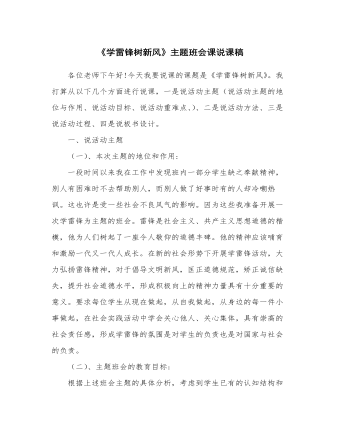
《学雷锋树新风》主题班会课说课稿
2、活动一——雷锋故事会(1)、让同学们展示课前收集的有关雷锋帮助别人的故事。使全体的同学都参与到这个活动中,发挥他们的积极性。(2)、为了丰富教育资源我在此处为学生准备了《可敬的“傻子”》、《雨夜送大嫂》、《人民的勤务员》三个故事,进行补允让学生更加全面的了解雷锋精神。设计此活动的目的是陶冶学生情操,让学生更加深入的了解勤俭朴素、助人为乐、全心全意为人民服务雷锋形象。3、活动二一一读《雷锋日记》让学生读雷锋给一位陌生老人送完手套后写的日记。重点理解“一路上,我的手虽冻得像针扎一样,心中却有一种说不出的愉快。”这一句话。让学生谈谈自己的感受。此活动的目的是让学生了解雷锋的内心世界,理解雷锋精神的实质,全心合意为人民服务。
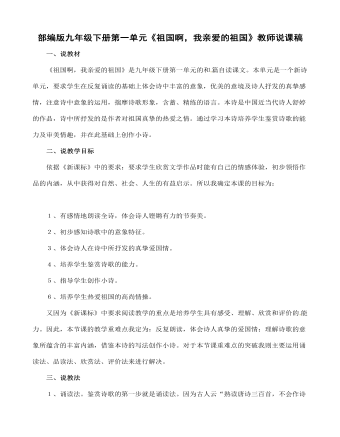
九年级祖国啊我亲爱的祖国说课稿
二、说教学目标 依据《新课标》中的要求:要求学生欣赏文学作品时能有自己的情感体验,初步领悟作品的内涵,从中获得对自然、社会、人生的有益启示。所以我确定本课的目标为:[来源:学_ 1、有感情地朗读全诗,体会诗人铿锵有力的节奏美。 2、初步感知诗歌中的意象特征。 3、体会诗人在诗中所抒发的真挚爱国情。 4、培养学生鉴赏诗歌的能力。 5、指导学生创作小诗。[来源:学科XK 6、培养学生热爱祖国的高尚情操。
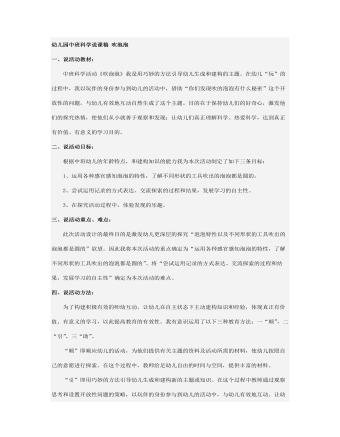
幼儿园中班科学说课稿 吹泡泡
为了构建积极有效的师幼互动,让幼儿在自主状态下主动建构知识和经验,体现真正有价值、有意义的学习,以此提高教育的有效性。我有意识运用了以下三种教育方法:一“顺”,二“引”,三“助”。 “顺”即顺应幼儿的活动,为他们提供有关主题的资料及活动所需的材料,使幼儿按照自己的意愿进行探索。在这个过程中,教师给足幼儿自由的时间与空间,提供丰富的材料。 “引”即用巧妙的方法引导幼儿生成和建构新的主题或知识。在这个过程中教师通过观察思考和设置开放性问题的策略,以玩伴的身份参与到幼儿的活动中,与幼儿有效地互动。让幼儿在“玩”中学,在学中“玩”。 “助”即教师在适当的时候“助”幼儿一臂之力,对幼儿进行点拔,借助当时的情景、材料,直接地提出主题,把幼儿的学习兴趣推向深入。
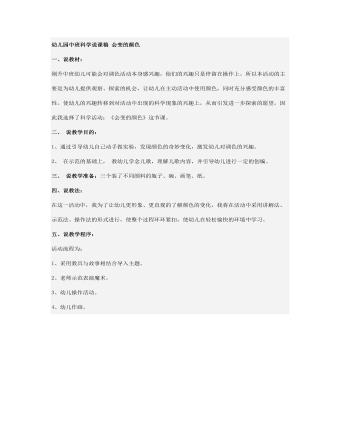
幼儿园中班科学说课稿 会变的颜色
刚升中班幼儿可能会对调色活动本身感兴趣,他们的兴趣只是停留在操作上。所以本活动的主要是为幼儿提供观察、探索的机会,让幼儿在主动活动中使用颜色,同时充分感受颜色的丰富性。使幼儿的兴趣转移到对活动中出现的科学现象的兴趣上,从而引发进一步探索的愿望。因此我选择了科学活动:《会变的颜色》这节课。

幼儿园中班科学说课稿 火箭升空
在幼儿进行实验的时候,大部分孩子都能够认真的去寻找反作用力,只有极个别孩子只对某一样东西感兴趣,所以就不太主动的去进行其他的探索实验,根据这个情况,我对这样的孩子也进行了正确的引导,在实验结束的时候,大部分孩子都能够在不同的物体中找到反作用力。 我上的这节课是科学活动《火箭升空》这是整合课程《交通工具博览会》主题中的一个活动。 下面我先说一下这节课的活动目标: 1、拓展幼儿的想像力及对科学的探索能力。 2、尝试了解火箭升空的动力。 3、初步了解反作用力。 首先,我说一下这节课的设计意图,在《交通工具博览会》主题活动中,我们班的孩子对于火箭都非常好奇,感兴趣,平时提到火箭孩子们也都很兴奋,他们虽然知道火箭,喜欢火箭,但是火箭对于他们来说具体是一个什么样的概念,他们还不是很了解。

幼儿园中班科学说课稿:吹泡泡
二、说活动目标: 根据中班幼儿的年龄特点,和建构知识的能力我为本次活动制定了如下三条目标:1、运用各种感官感知泡泡的特性,了解不同形状的工具吹出的泡泡都是圆的。2、尝试运用记录的方式表达、交流探索的过程和结果,发展学习的自主性。3、在探究活动过程中,体验发现的乐趣。三、说活动重点、难点: 此次活动设计的最终目的是激发幼儿更深层的探究“泡泡特性以及不同形状的工具吹出的泡泡都是圆的”欲望。因此我将本次活动的重点确定为“运用各种感官感知泡泡的特性,了解不同形状的工具吹出的泡泡都是圆的”。将“尝试运用记录的方式表达、交流探索的过程和结果,发展学习的自主性”确定为本次活动的难点。
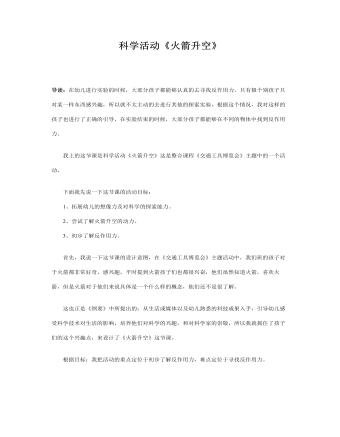
幼儿园中班科学说课稿:火箭升空
我上的这节课是科学活动《火箭升空》这是整合课程《交通工具博览会》主题中的一个活动。 下面我先说一下这节课的活动目标:1、拓展幼儿的想像力及对科学的探索能力。2、尝试了解火箭升空的动力。3、初步了解反作用力。 首先,我说一下这节课的设计意图,在《交通工具博览会》主题活动中,我们班的孩子对于火箭都非常好奇,感兴趣,平时提到火箭孩子们也都很兴奋,他们虽然知道火箭,喜欢火箭,但是火箭对于他们来说具体是一个什么样的概念,他们还不是很了解。 这也正是《纲要》中所提出的:从生活或媒体以及幼儿熟悉的科技成果入手,引导幼儿感受科学技术对生活的影响,培养他们对科学的兴趣,和对科学家的崇敬,所以我就抓住了孩子们的这个兴趣点,来设计了《火箭升空》这节课。

幼儿园中班科学说课稿:会变的颜色
一、说教材:刚升中班幼儿可能会对调色活动本身感兴趣,他们的兴趣只是停留在操作上。所以本活动的主要是为幼儿提供观察、探索的机会,让幼儿在主动活动中使用颜色,同时充分感受颜色的丰富性。使幼儿的兴趣转移到对活动中出现的科学现象的兴趣上,从而引发进一步探索的愿望。因此我选择了科学活动:《会变的颜色》这节课。二、说教学目的:1、通过引导幼儿自己动手做实验,发现颜色的奇妙变化,激发幼儿对调色的兴趣。2、在示范的基础上,教幼儿学念儿歌,理解儿歌内容,并引导幼儿进行一定的创编。